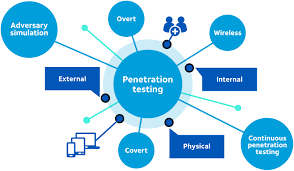Identify and Fix Vulnerabilities with Web App Testing
Web
applications are the backbone of modern businesses, connecting users with
services, data, and functionalities. However, their ubiquity and complexity
make them a prime target for cyber threats. This makes web application testing
and vulnerability assessments essential to ensure security, functionality, and
compliance. This article explores key aspects of web
app testing, highlights vulnerabilities, and discusses strategies to
fix them.
The Importance of Web Application Testing
Web
applications face constant exposure to internal and external threats. Without
thorough testing, they risk being compromised, leading to data breaches,
financial losses, and reputational damage. Web app testing ensures that:
Applications
are secure against cyberattacks.
Performance
remains consistent under varying loads.
Functionalities
meet user requirements.
Compliance
with industry standards and regulations is maintained.
Categories of Web App Testing
Functional
Testing
focuses on verifying that all features of the application work as intended. It
involves checking forms, buttons, workflows, and other functionalities.
Performance
Testing
Ensures the application performs optimally under different conditions, such as
heavy user traffic.
Security
Testing
Identifies vulnerabilities that could be exploited by attackers, such as weak
authentication mechanisms or unpatched software.
Usability
Testing
Evaluates the user interface and user experience, ensuring accessibility and
ease of use.
Compatibility
Testing
Verifies the app works seamlessly across different devices, browsers, and
operating systems.
Common Vulnerabilities in Web Applications
Understanding
common vulnerabilities is crucial for effective testing and remediation. Some
prevalent weaknesses include:
1. Injection
Attacks
What It Is:
Attackers inject malicious code (e.g., SQL or XSS) into the application,
exploiting improperly sanitized inputs.
Impact:
Data theft, unauthorized access, and database corruption.
Prevention:
Use prepared
statements and parameterized queries.
Validate and
sanitize user inputs.
2. Cross-Site
Scripting (XSS)
What It Is:
Attackers inject malicious scripts into web pages viewed by other users.
Impact:
Session hijacking, defacement, and data theft.
Prevention:
Use proper
output encoding.
Implement
Content Security Policies (CSP).
3. Broken
Authentication
What It Is:
Poor implementation of authentication mechanisms allows attackers to bypass
login systems.
Impact:
Unauthorized access to sensitive data and systems.
Prevention:
Implement
strong password policies.
Use
multi-factor authentication (MFA).
4. Sensitive Data Exposure
What It Is:
Applications fail to secure sensitive data, such as passwords, credit card numbers,
or personal information.
Impact:
Identity theft, financial fraud, and legal implications.
Prevention:
Use
encryption (TLS/SSL) for data in transit.
Store data
securely using hashing algorithms like bcrypt or Argon2.
5. Security
Misconfiguration
What It Is:
Default configurations, unnecessary features, or improperly secured components
increase vulnerability risks.
Impact:
Enables attackers to exploit overlooked weaknesses.
Prevention:
Regularly
update and patch systems.
Disable
unused services and features.
6. Insecure Deserialization
What It Is:
Attackers exploit insecure mechanisms for serializing and deserializing data to
execute arbitrary code.
Impact:
Remote code execution, privilege escalation, and data tampering.
Prevention:
Avoid
accepting serialized objects from untrusted sources.
Use secure
libraries and implement strict validation.
Steps for Effective Web App Testing and Vulnerability Assessment
1. Planning
and Preparation
Define the
scope of testing, including assets, features, and objectives.
Identify key
stakeholders and obtain necessary permissions.
2. Automated
and Manual Testing
Use
automated tools like OWASP ZAP, Burp Suite, or Nessus to scan for
vulnerabilities.
Conduct
manual testing to uncover complex issues missed by automated tools.
3. Code
Reviews
Perform
static and dynamic code analysis to identify potential vulnerabilities.
Adopt secure
coding practices to address flaws at the source.
4. Penetration
Testing
Simulate
real-world attack scenarios to evaluate the app's resilience.
Prioritize
fixing vulnerabilities based on their severity.
5. Regular
Updates and Patching
Keep all
software dependencies, frameworks, and libraries updated.
Regularly
apply security patches to mitigate emerging threats.
6. Monitoring
and Logging
Implement
robust monitoring to detect and respond to security incidents in real-time.
Use
centralized logging for better analysis and troubleshooting.
Tools for Web App Testing and Vulnerability Assessment
Several
tools facilitate comprehensive web application testing:
OWASP ZAP –
Open-source tool for finding vulnerabilities in web applications.
Burp Suite –
A popular platform for penetration testing.
Acunetix –
An automated scanner for detecting vulnerabilities like SQL Injection and XSS.
Nessus –
Specializes in identifying misconfigurations and missing patches.
SAST Tools –
Static Application Security Testing tools like SonarQube for analyzing source
code.
Best Practices for Fixing Vulnerabilities
Adopt Secure
Development Practices
Integrate security into the software development lifecycle (SDLC) with
practices like DevSecOps.
Implement
Strong Authentication and Authorization
Use modern authentication methods, enforce role-based access controls, and
regularly review permissions.
Conduct
Regular Security Audits
Schedule routine audits to assess and reinforce security measures.
Educate Development
Teams
Train developers on secure coding practices and common vulnerabilities.
Use a WAF
(Web Application Firewall)
Deploy a WAF to block malicious traffic and protect against common attacks.
Conclusion
Web
application testing and vulnerability assessments are indispensable for maintaining
security, reliability, and user trust. Identifying and fixing vulnerabilities
proactively minimizes risks and ensures compliance with industry standards. By
leveraging automated tools, conducting manual reviews, and adopting secure
practices, organizations can strengthen their web applications against the
ever-evolving threat landscape. Investing in robust testing not only protects
data and systems but also upholds your organization's reputation in an
increasingly interconnected digital world.
.jpeg)
.jpeg)

.jpeg)
Comments
Post a Comment